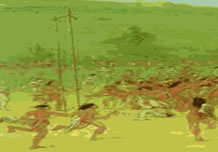|
|
|
| |
LOUISIANA INDIANS TODAY
Federal Recognized Tribes
State Recognized Tribes
|
 |
 |
Clifton Choctaw
P.O. Box 32
Gardner, LA 71431
(318) 793-8796
Anna Neal, Administrative Representative |
United Houma Nation
20986, Highway 1
Golden Meadow, LA 70357
(504) 851-1550
Kirby Vernet, Chairman |
 |
Students have divided the Indians of
Louisiana into three linguistic groups -
Tunican,
Caddoan,
and Muskhogen.
Each group may be subdivided into the
lesser units or tribes enumerated below.
This group was comprise of the
Tunican family proper (the Washa, Koroa, and Chawasha tribes),
the Opelousas, the Chitimacha, and the Attakapa tribes. Members
of these tribes lived in the northeast corner of present-day
Louisiana (the Koroa) and in the coastal region (Attakapa
and Chitimacha). The Chitimacha culture was a notably advanced
one, the members of this tribe being proficient in craftsmanship,
both of basketry and metal work. Their descendants still live
on the Chitimacha reservation in St. Mary Parish.
A settlement
since 1764, the Chitimacha reservation was established by
the federal government in 1935.
Located at Charenton near Baldwin, it comprises approximately
280 acres. For reservation privileges each person must have
at least one-quarter Indian blood. The Indians receive regular
government payments and have small farms and simply furnished
homes. Most speak English, but the older ones prefer French.
Some knew a few words of their original Indian tongue.
The Chitimacha were a proud
and noble tribe and their descendants constitute the Indian
aristocracy of Louisiana. The Attakapa and Opelousas Indians
were related. The Attakapa, it seems, have borne the brunt
of historical misconceptions regarding their cultural development,
supposed cannibalism, and living habits in general.
Studies of their
language made by the SmithsonianInstitute in 1885, and later
research by Hubert Daniel Singleton in the 1990's, show a
people both culturally concise and inventive.
Their
language correlates to classic Greek and Roman by their conjugation
of verbs with regard to person, number, and tense. They were
a people who practiced religion regularly and mastered herbal
remedies, horticulture, and agriculture. Their handcrafted
cypress canoes were seaworthy enough to withstand the open
waters of the Gulf of Mexico. The term cannibal was applied
to them only as an insult by the Choctaws.
The European settlers in Louisiana, however, according to
Mr. Singleton's research, took this diatribe seriously and
unfortunately helped keep the rumor alive. There is no recorded
instance of the practice of cannibalism by the much-maligned
Attakapa. Although the practice of their language is extinct,
the Attakapa are not. Some of their descendants now dwell
in the southwest part of Louisiana; other descendants have
migrated to other sections of the state.
The Washa, Chawasha, and Koroa
tribes were all small and either died out or became indistinct
through intermarriage into larger tribes.
Caddoan Family
This group included
the Yatasi, Doustioni, Kadohacho, Adai, Washita, and Natchitoches
tribes. These tribes were located generally in the northwest
corner of the state area on or near the banks of the Red River
north of modern Alexandria.
The
group had a particularly difficult time after the coming of
the whites since their location placed them in a no-man's-land
between the rival French and Spanish empires. Eventually,
after repeated difficulties with French, Spanish, and finally
the neighboring Texans, the Caddoans fled by force march in
1859 to Oklahoma, where their descendants still live.
Muskhogean Family
This group
was made up of the Muskhogean family proper (the Taensa, Okelousa,
Bayougoula, Quinipissa, Avoyels, Tangipahoa, Acolapissa, Houma,
and Choctaw tribes) and the related Natcheans, the former
inhabiting the southeastern part of Louisiana, and the latter
the east central area of the state.
In 1700 the Muskhogeans lived in more than 60 villages and
numbered about 3,500. The Muskhogean tribe best remembered
in American history is the Choctaw who lived north of Lake
Pontchartrain. They were the first major tribe to form an
alliance with the French in Louisiana. They aided the French
on several occasions in fighting against their linguistic
relatives, the Natchez. While most Choctaw live in what is
now the state of Mississippi, many migrated to Louisiana.
For more information,
you might wish to contact the Governor's Office of Indian
Affairs, Diana S. Williamson, Executive Director, 1886 Wooddale,
Blve., Suite 1100, Baton Rouge, L.A.
70806, (504) 925-4509, FAX: (504) 925-4508
LOUISIANA INDIANS- GENERAL
With the possible exception
o the Caddoans, whose northern location gave them access to
buffalo hunting on the plains, all the Indians who lived in
what is now Louisiana were of a semisedentary type, relying
on agriculture and fishing for thwir main subsistence. Indian
corn (maize) was the most important diet crop, although it
was supplemented by beans, pumbkins, and melons, which were
also grown domestically, and by fish and game.
Indian settlements
were always located on the banks of rivers or streams.
There were weveral types of dwellings, depending on the resources
available for construction in any given area. In the northern
part of the state, houses usually had aframe of wooden poles
and mud-plastered roofs covered with grass. Houses in the
southern part were of palmetto leaves over a frame- work of
poles. In eash village one or more granaries were built above
the ground on high posts where corn could be stored and protected
from mice.
As of
1700, the Indians in what is now the state of Louisiana numbered
about 13,000, or one to every four square miles. After decreasing almost to extinction, they reversed the trend
after 1850. The 1940 census gives a total Indian population
of 1,801 for the state, very few pure-blooded. The 1950 census
counted only 409, but the 1960 census showed 3,587 Indians
in Louisiana, an increase of 777 percent in 10 years. The
1980 census reported that 12,065 American Indians, Eskimos,
and Aleutians lived in Louisiana.
|
|
 |
 |
|

